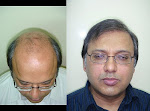Wednesday, September 24, 2014
Sunday, September 7, 2014
Hair transplantation
Hair transplantation is a surgical technique that moves individual hair follicles from a part of the body called the 'donor site' to bald or balding part of the body known as the 'recipient site'. It is primarily used to treat male pattern baldness. In this minimally invasive procedure, grafts containing hair follicles that are genetically resistant to balding are transplanted to the bald scalp. It can also be used to restore eyelashes, eyebrows, beard hair, chest hair, pubic hair and to fill in scars caused by accidents or surgery such as face-lifts and previous hair transplants. Hair transplantation differs from skin grafting in that grafts contain almost all of the epidermis and dermis surrounding the hair follicle, and many tiny grafts are transplanted rather than a single strip of skin.
Since hair naturally grows in groupings of 1 to 4 hairs, today’s most advanced techniques harvest and transplant these naturally occurring 1–4 hair "follicular units" in their natural groupings. Thus modern hair transplantation can achieve a natural appearance by mimicking nature hair for hair. This hair transplant procedure is called Follicular unit transplantation(FUT). Donor hair can be harvested two different ways: strip harvesting, and follicular unit extraction (FUE).
Surgery
Example of a graft transplantation to cover the scar of a Hidradenitis suppurativa operation on the back of the head
Transplant operations are performed on an outpatient basis, with mild sedation (optional) and injected local anesthesia, which typically last about six hours. The scalp is shampooed and then treated with an antibacterial agent prior to the donor scalp being harvested.
There are several different techniques available for the harvesting of hair follicles, each with their own advantages and disadvantages. Regardless of which donor harvesting technique is employed, proper extraction of the hair follicle is paramount to ensure the viability of the transplanted hair and avoid transection, the cutting of the hair shaft from the hair follicle. Hair follicles grow at a slight angle to the skin's surface, which means that regardless of technique transplant tissue must be removed with a corresponding angle and not perpendicular to the surface.
There are two main ways in which donor grafts are extracted today: strip excision harvesting, and follicular unit extraction.
Subscribe to:
Posts (Atom)


















